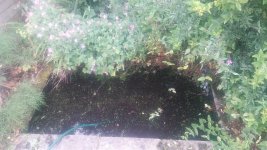Apologies if there is a better suited forum for this post. my thinking was that experts on amphibians might also be experts on ponds...
Today I cleaned my grandma's pond, which is about 1m x 2m x 0.5m. It was hidden by overgrown bushes which i have cut back. It had a very thick layer of duckweed, which i have removed and was full of twigs, small branches and leaves. It is devoid of life and has a nasty stagnant smell (not eggy, just stagnant mud smell). The water is also a bit dirty, maybe from mud i was disturbing.
Could anyone advise me how to bring this pond back to life? it used to be full of frogs and newts. Thanks, Richard
Today I cleaned my grandma's pond, which is about 1m x 2m x 0.5m. It was hidden by overgrown bushes which i have cut back. It had a very thick layer of duckweed, which i have removed and was full of twigs, small branches and leaves. It is devoid of life and has a nasty stagnant smell (not eggy, just stagnant mud smell). The water is also a bit dirty, maybe from mud i was disturbing.
Could anyone advise me how to bring this pond back to life? it used to be full of frogs and newts. Thanks, Richard






